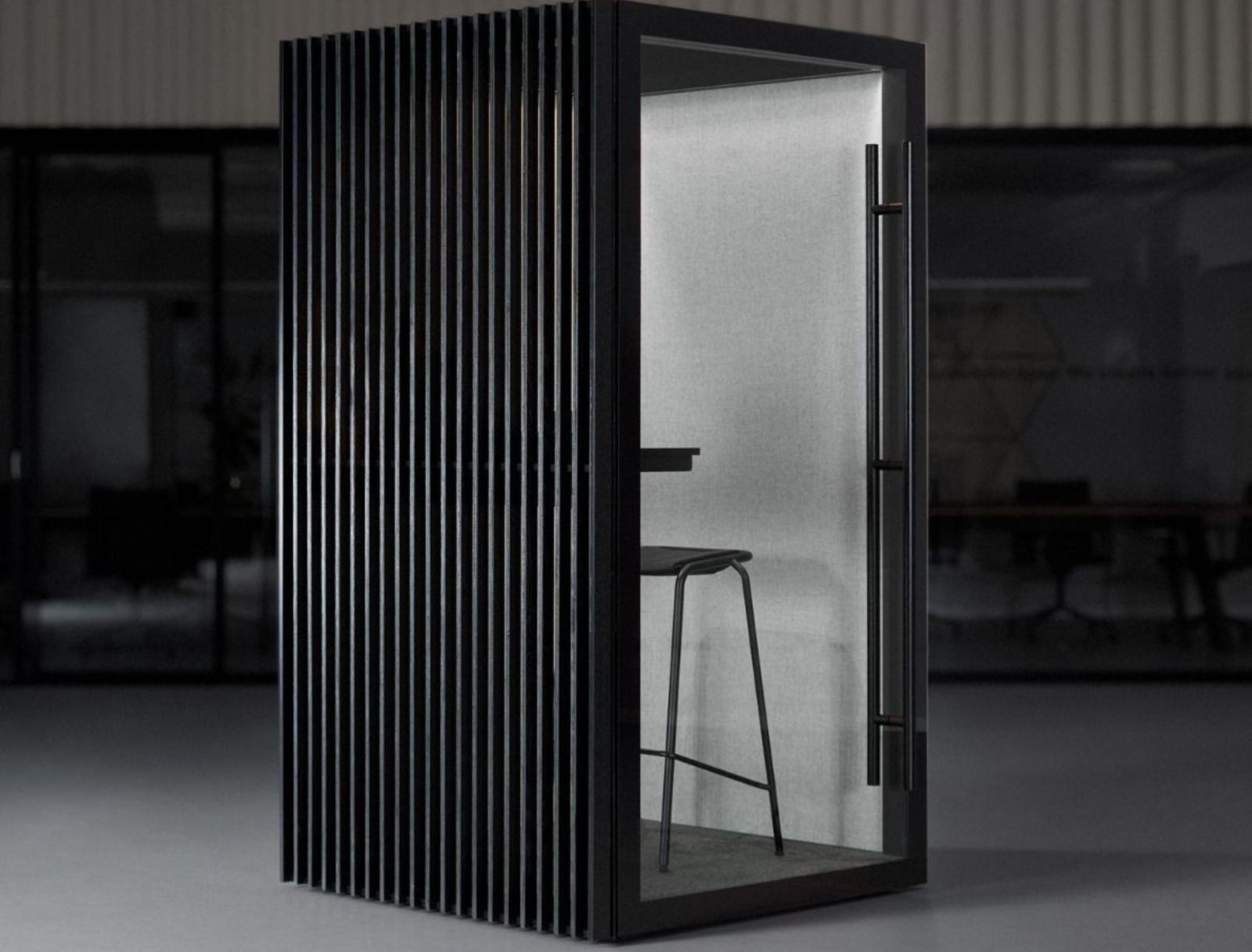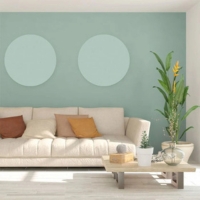
Only sustainable products
Configurable products
Installation available
Free acoustic advice
The Importance of Acoustics in Audio Visual Rooms
Acoustics in AV Rooms: Why It Matters
Good acoustics can make or break an audio-visual (AV) room. Whether you're setting up a home theater, conference room, or recording studio, getting the sound right is key. Let's explore why acoustics and acoustic panels can be so important and to improving them.
Key Takeaways for AV Room Acoustics
- Speech intelligibility can improve by up to 35%
- Ideal reverberation time (RT60) for conference rooms: 0.6-0.8 seconds
- Recommended background noise level: 30-35 dBA
- 73% of organizations report improved collaboration with integrated AV solutions
- Proper acoustic treatment can significantly enhance sound quality
- Room size and shape play crucial roles in sound behavior
- Balancing absorption, diffusion, and bass trapping is essential
- Lighting considerations are important for overall AV experience
Why Acoustics Matter in AV Rooms
Proper acoustics help everyone hear clearly. In fact, good acoustics can boost how well we understand speech by up to 35%! That's huge for meetings or watching movies. Here are some key things to know:
These numbers show just how much acoustics can affect an AV room. Let's break down what makes good acoustics and how to achieve them.
The Basics of AV Room Acoustics
When setting up an AV room, you need to think about three main things: the room's size and shape, how sound bounces around (reverberation), and background noise. Getting these right can make a big difference in how things sound.
Room size matters because sound waves need space to move. A room that's too small can make sound muddy, while one that's too big might create echoes. The "Golden Ratio" is often used to figure out the best room dimensions for sound. This ratio (1:1.6:2.6) helps create a balanced acoustic environment and minimizes standing waves.
Reverberation is how long sound hangs around in a room after it's made. For conference rooms, you want a reverberation time between 0.6 and 0.8 seconds. This helps voices sound clear without being too "dead" or echoey. Too much reverberation can make speech unintelligible, while too little can make the room feel uncomfortably dry.
Treating Your Room for Better Sound
Now that we know why acoustics matter, let's look at how to improve them. There are three main ways to treat a room: absorption, diffusion, and bass trapping. Each of these methods addresses different aspects of sound behavior in a space.
Sound Absorption
Sound absorption helps cut down on echoes and reverb. One great way to do this is with acoustic panels. These panels soak up sound waves, making the room sound clearer. Eco Sound acoustic slat wall panels are a good option. They look lovely and are simple to install.
These panels start at £124.95 and are innovative, sustainable, and high-performance. They're great for both looks and sound. The slat design not only absorbs sound but also provides some diffusion, making them a versatile choice for many AV rooms.
Sound Diffusion
Diffusion spreads sound waves around evenly. This helps prevent harsh echoes and makes the room sound more natural. You can use special diffuser panels or even bookshelves to achieve this effect. Diffusion is particularly important in larger rooms or spaces where you want to maintain some liveliness while avoiding distinct echoes.
Bass Trapping
Bass traps handle low-frequency sounds, which can be tricky in small rooms. The Autex Cube PET Acoustic Panel can help with this. It's lightweight, versatile, and customizable.
Starting at £269.00, these panels can make a big difference in how your room sounds, especially for lower tones. Bass traps are often placed in room corners where low-frequency sound tends to accumulate.
Choosing the Right AV Equipment
Good acoustics aren't just about the room - your equipment matters too. Here are some things to think about:
- 1. Microphones: Choose between directional (good for noisy rooms) and omnidirectional (better for quiet spaces). Consider the pickup pattern that best suits your room's acoustics and intended use.
- 2. Speakers: Line array systems can help spread sound evenly across the room. The placement and type of speakers can significantly impact sound distribution and clarity.
- 3. Displays: 4K and 8K screens are becoming more common, offering super clear images. Consider the viewing distance and room size when selecting display resolution.
Remember, even the best equipment won't sound good in a room with poor acoustics. That's why treating your room is so important. The synergy between room acoustics and AV equipment is crucial for optimal performance.
For an easy-to-install option, check out the Silent Space Acoustic Panel. Starting at £99.95, it's lightweight and cost-effective. These panels can be strategically placed to address specific acoustic issues in your room.
Keeping Sound In (and Out)
Soundproofing is another important part of AV room acoustics. It helps keep outside noise out and inside sound in. Here are some key things to know:
- Sound Transmission Class (STC): This measures how well a wall blocks sound. Higher is better. An STC rating of 50 or above is considered excellent for most applications.
- Noise Reduction Coefficient (NRC): This shows how much sound a material absorbs. Again, higher is better. An NRC of 0.75 means the material absorbs 75% of the sound that hits it.
To soundproof effectively, you might need to add mass to walls, seal gaps, or use special sound-blocking materials.
The Lignosi Eco Sound Timber Acoustic Panels can help with this.
Starting at £109.95, these panels offer a luxurious look while helping to control sound. They're particularly effective at absorbing mid to high frequencies, which can help balance the overall room acoustics.
Making Sound Crystal Clear
Once you've got your room treated and soundproofed, it's time to fine-tune the audio. Here's what to focus on:
- Signal-to-noise ratio: This is the difference between the sound you want (signal) and background noise. Higher is better. Aim for at least 20 dB for good intelligibility.
- Speech intelligibility: This is how easy it is to understand spoken words. Good acoustics can really help with this. The Speech Transmission Index (STI) is a common measure, with values above 0.75 considered excellent.
- Balancing different audio sources: Make sure all your audio sources (mics, speakers, etc.) work well together. This often involves careful calibration and equalization.
The Autex Cube Acoustic Panel can help achieve this balance. It's customizable and versatile, starting at £239.00.
Let There Be Light (But Not Too Much)
Lighting is often overlooked in AV rooms, but it's super important. You need enough light to see, but not so much that it causes glare on screens. Here are some tips:
- Use dimmable lights so you can adjust based on what you're doing. LED lights with a wide dimming range are ideal.
- Avoid putting lights directly above or behind screens to prevent glare. Indirect lighting can be very effective in AV rooms.
- Consider lights that can change color temperature for different moods or uses. A range from 2700K (warm) to 6500K (cool) gives you plenty of flexibility.
Some acoustic solutions, like the Abstracta Trumpet Suspended Absorber, even come with built-in lighting options.
Starting at £715.00, this absorber is effective yet subtle and can be ordered with or without lighting. It's a great example of how acoustic treatment can be integrated with other room functions.
Different Rooms, Different Needs
Not all AV rooms are the same. Here's a quick rundown of what to consider for different types:
Home Theaters
Focus on creating an immersive experience. Use plenty of absorption to control reflections and consider bass traps for those booming movie soundtracks. Aim for a reverberation time around 0.3 to 0.5 seconds for optimal clarity and impact.

Conference Rooms
Clarity is key. Aim for a balance of absorption and diffusion to keep voices clear without sounding too "dead." A reverberation time of 0.6 to 0.8 seconds is ideal for most conference rooms. Pay special attention to speech intelligibility and even sound distribution.
Classrooms
Similar to conference rooms, but you might need more absorption to handle the extra noise from students. Consider the room's shape and size to ensure that sound reaches all areas clearly. Aim for a slightly longer reverberation time of 0.7 to 1.0 seconds to support both speaking and listening.
Recording Studios
These need the most precise acoustics. You'll want a mix of absorption, diffusion, and bass trapping to create a neutral sound. Aim for a very short reverberation time, typically 0.2 to 0.4 seconds, depending on the studio's size and purpose. Pay extra attention to low-frequency control and overall frequency response.

Wrapping It Up
Good acoustics are crucial for any AV room. They help make sound clearer, reduce echoes, and create a better overall experience. Whether you're setting up a home theater, conference room, or recording studio, taking the time to get the acoustics right will make a huge difference.
Remember these key points:
- Use a mix of absorption, diffusion, and bass trapping to control sound. Each plays a unique role in shaping the room's acoustics.
- Choose the right equipment for your space. The best gear won't perform well in a poorly treated room.
- Don't forget about lighting - it's part of the AV experience too. Proper lighting enhances visibility without compromising screen clarity.
- Different rooms have different needs - plan accordingly. Tailor your acoustic treatment to the specific purpose of the room.
- Consider professional help for complex setups. Sometimes, expert advice can save time and ensure optimal results.
With the right acoustic treatments and setup, you can transform any room into an awesome AV space. And if you need help, Sonio offers professional fitting services to make sure everything's installed perfectly.
Now you're ready to create an AV room that looks great and sounds even better. Remember, good acoustics are an investment in your audio-visual experience, whether for work, entertainment, or creativity. Happy listening!
[related_products is_auto_added="1"] Acoustic Wall Panels
Acoustic Wall Panels  Acoustic Ceiling Panels
Acoustic Ceiling Panels  Acoustic Ceiling Baffles
Acoustic Ceiling Baffles  Acoustic Screens
Acoustic Screens  Acoustic Fabric
Acoustic Fabric  Acoustic Lighting
Acoustic Lighting  Acoustic Booths and Pods
Acoustic Booths and Pods  Acoustic Panel Accessories
Acoustic Panel Accessories 











































